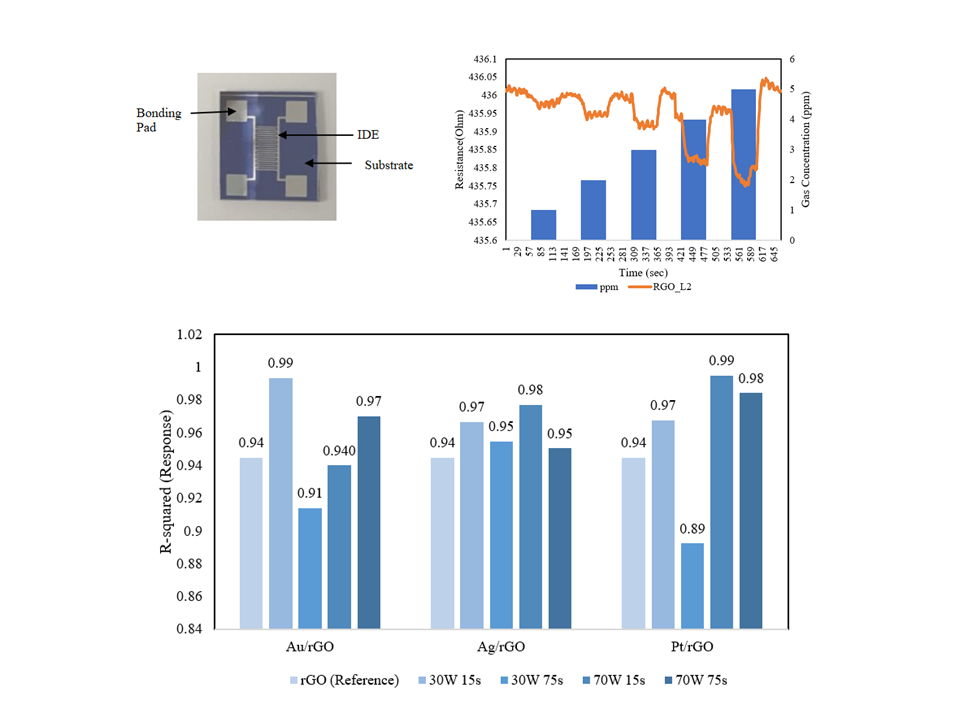Graphical Abstract

References
1. Zhang,
H., Li, Q., Huang, J., Du, Y. and Ruan, S. C. (2016). Reduced graphene oxide /
Au Nanocomposite for NO2 sensing at low operating temperature. Sensor,
16(2): 1-9.
2. Abdel-Karim, R.,
Reda, Y. and Abdel-Fattah, A. (2020). Review: Nanostructured materials-based
nanosensors. Journal of The Electrochemical Society, 167: 037554.
3. Paula, M., Gil,
G., Sandra, C., Nuno, A., Manoj, S., Jos, G. and Antnio, S. (2017),
Functionalized graphene nanocomposites. Advances in Nanocomposite
Technology, 2017: 11-15.
4. Behi, S., Bohli,
N., Casanova-ch, J. and Llobet, E. (2020). Metal oxide nanoparticle-decorated
few layer graphene nanoflake chemoresistors for the detection of aromatic
volatile organic compounds. Sensors, 20: 3413:1-15.
5. Lipatov, A.,
Varezhnikov, A., Wilson, P. and Sysoev, V. V. (2013). Highly selective gas
sensor arrays based on thermally reduced graphene oxide. Nanoscale, 5:
5426-5434.
6. Abdullah, M. F.,
Soriadi, N., Yakin, F.S.M, Badaruddin, S.A.M. and Syono, M. I. (2020).
Materials science in semiconductor processing tuning the optoelectronic
properties of the rGO-AuNPs hybrid film by pre-decoration and AuNPs-assisted
thermal reduction. Materials Science in Semiconductor Processing, 112:
105017.
7. Wang, C., Lei,
S., Li, X., Guo, S., Cui, P., Wei, X., Liu, W. and Liu, H. (2018). A reduced
GO-graphene hybrid gas sensor for ultra-low concentration ammonia detection. Sensors
(Switzerland), 18(9): 3147.
8. Mirzaei, A.,
Lee, J., Majhi, S. M., Weber, M., Bechelany, M. and Kim, H. W. (2019).
Resistive gas sensors based on metal-oxide nanowires Resistive gas sensors
based on metal-oxide nanowires. Journal of Applied Physics, 2019:
241102.
9. Malika, K., Kim,
T., Losic, D. and Thanh, T. (2016). Recent advances in engineered graphene and
composites for detection of volatile organic compounds (VOCs) and non-invasive
diseases diagnosis. Carbon, 110: 97-129.
10. Ghimenti, S.,
Francesco, F. Di, Onor, M., Pleil, J. D., Stiegel, M. A., Sobus, J. R.,
Unterkofler, K., King, J., Mochalski, P., Pleil, J. D., Stiegel, M. A. and
Risby, T. H. (2013), Clinical breath analysis : discriminating between
human endogenous compounds and exogenous (environmental) chemical confounder. Journal
of Breath Research, 7: 1-11.
11. Gaude, E.,
Nakhleh, M. K., Patassini, S., Boschmans, J., Allsworth, M., Boyle, B., and Van
Der Schee, M. P. (2019), Targeted breath analysis: Exogenous volatile organic
compounds (EVOC) as metabolic pathway-specific probe. Journal of Breath
Research, 13(3): 032001.
12. Yakin, F. S. M.,
Abdullah, M. F., Badaruddin, S. A, Syono, M. I. and Soriadi, N. (2021), Surface
modification and properties modulation of rGO film by short duration H2
and NH3 plasma treatment. Materials Today: Proceedings, 42:
2996-3001.
13. Tombel, N. S. M.,
Badaruddin, S. A. M., Yakin, F. S. M.,
Zaki, H. F. M. and Syono, M. I. (2021). Detection of low PPM of volatile
organic compounds using nanomaterial functionalized reduced graphene oxide
sensor. AIP Conference Proceedings, 2368: 020004.
14. Amiri, V.,
Roshan, H., Mirzaei, A., Neri, G. and Ayesh, A. I. (2020). Nanostructured metal
oxide-based acetone gas sensors : a review. Sensors, 20: 3096.
15. Wang, C., Yin,
L., Zhang, L., Xiang, D. and Gao, R. (2010). Metal oxide gas sensors:
Sensitivity and influencing factors. Sensors, 10: 2088-2106.
16. Aniq, M.,
Mohammad, S., Wah, H., Bien, D. C. S., Hj, I., Azid, A., Woon, M. and Shukri,
S. (2014). Surface morphology, resistivity, and magnetoresistance of Co, Fe,
Ni, Co – Fe and Ni – Fe nanoparticles on TiN layers induced by hydrogen plasma
treatment. Thin Solid Films, 550: 22-26.
17. Arun, K.,
Lekshmi, M. S and Suja, K. (2021). Performance analysis, modeling, and
development of a signal conditioning unit of n-type metal oxide gas sensor for
acetone gas detection. Journal of Computational Electronics, 20: 1938-1947.
18. Arshak, K.,
Moore, E., Lyons, G.M., Harris, J. and Clifford, S. (2004). A review of gas
sensors employed in electronic nose applications. Sensor Review, 24:
181-198.
19. Vergara, A.,
Vembu, S., Ayhan, T., Ryan, M. A., Homer, M. L. and Huerta, R. (2012). Chemical
gas sensor drift compensation using classifier ensembles. Sensors and
Actuators, B: Chemical, 166-167: 320-329.
20. Gupta, S.,
Chatterjee, S., Ray, A. K. and Chakraborty, A. K. (2015). Graphene – metal
oxide nanohybrids for toxic gas sensor : A review. Sensors &
Actuators: B Chemical, 221(2): 1170-1181.
21. Zhou, C., Yu, J.,
Qin, Y. and Zheng, J. (2013). Grain size effects in polycrystalline gold
nanoparticles. Nanoscale, 4(14): 4228-4233.